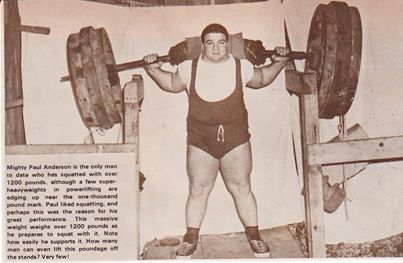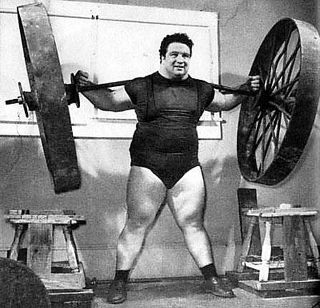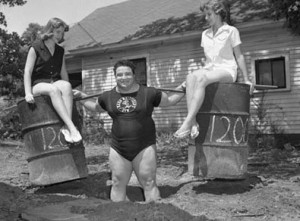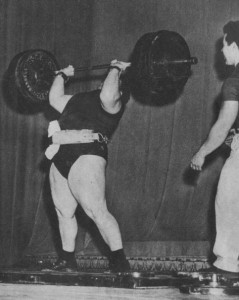Yellow Light Lifting
By John McKean
” Did you just hear an EXPLOSION??!!” spat out the angry, grumpy old neighbor. “Whatever that awful noise was, woke me from my nice nap!” screeched ole Mr. Raphaele from his back door.
The waggish, freckle faced little lad, standing in his own driveway, couldn’t help but answer “Nope, didn’t hear a thing! Maybe you should check the rear of your undershorts!”
With the subsequent loud slamming of his neighbor’s porch door, the boy returned to easily cleaning his lightly loaded barbell, and once again shot up a press with such velocity and momentum that the barbell rocketed ,when released, about 4′ above his extended arms. Then the young lifter got the hell out of the way as the bar crashed yet another time into his gravel driveway.
This wild, ballistic training eventually set up the youth for more structured training with ever heavier weights in local weightlifting clubs around his vicinity. You may have heard of him; he was Olympian Russ Knipp, a middleweight who established 9 press world records (usually with double bodyweight), and gave the Russians fits due to his pure strength strict presses (by then the Soviets and others had devolved into doing modified push jerks).
So what does the Knipper’s early training have to do with the “yellow light” title of this article? Well, I equate it to my wife’s driving around our crowded suburban area – as she approaches a stop light and it turns yellow, she instantly accelerates and speeds up, though most often having to hit the brakes as the light goes red! Young Russ Knipp attempted to develop what we used to call “fast twitch muscle fibers” (Lord knows what the “experts” call it these days!), Marilyn just enjoys driving fast and gliding through intersections !
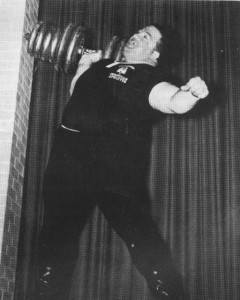
Paul Anderson was so adept at “speed lifting” that the author once witnessed Anderson one arm press a 275 pound dumbbell for 3 fast reps within a blink of the eye!
Years ago I wrote a story on “speed singles” using lighter weights as a backdown set from heavier near limit singles, to be done in a fast ballistic manner. Since the idea came from material that legendary Paul Anderson had given me, concerning using bodyweight high jumping squats following my squatting program, I immediately acquired a great deal of confidence in this “speed” supplement. Also, fast repped sets as “backdown” work following heavier lifting was much of the training basis of old pal Bob Weaver (first powerlifter to officially squat over 800# in a National Championship), and great results in my early powerlifting career came with their application.
Recently, with revitalized interest in power rack holds for all-round lifts, it occurred to me that I should experiment with speed work (or” yellow light lifting”,in deference to my wife!) BEFORE hitting limit weights in the rack. Sort of like a tune up,to have all muscle fibers firing when following with a rack overload for a hold. Of course I needed some resistance, though not much, and wished to use something that would NOT simply accelerate and allow momentum to throw it through its range with little muscle involvement. The good ole rubber cables came to the forefront once again! I now grab a few moderate strength bands that are easy ,yet a slight bit challenging, and WARMUP, prior to rack holds, with 3 very quick sets of an explosive 4 reps. Usually I do these with three main exercises(similar in nature to the LIFTS I’ll be soon doing within a power rack), and believe me, the entire body gets totally warm, actually HOT ! The mind is on fire ,too, and I’m ready to tackle anything!
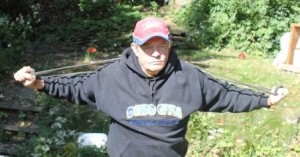
Author John McKean demonstrating one of his “yellow light” band warmups before proceeding to heavy rack overloads
After the “yellow light” band work, I immediately go with just ONE all out power rack middle range hold for 3 top-strength all-round movements. These holds are done much in the manner of what world record holder Bill March did in his pioneering rack routines – starting with a very heavy weight that just allows a push off lower pins ,up to a set of rack pins 4″ higher,then a severe isometric push (really a hold -those steel pins ain’t going anywhere!). I’ve found over the years that working the midsection of a lift only, rather than multiple positions is best for strengthening almost any lift, and to allow most progression in poundage (which should continually be increased!). I need no build up poundages within the rack as the speed band sets has me so primed and ready! Just one all-out slight movement & iso ! Even as I approach “early middle age”(ok, ok, I’m 72), I’m seeing some startling increases in rack poundages, and my usual training partner & grandson,at 12 years old, already has gained so quickly that he outweighs me by 30 very solid pounds and is a monster-in-the-making ! By the way,pick your favorite lifts for this program to really get into it ;currently young Andraes and I use the belt squat, bentover row, and close grip floor press. Our band “yellow lighters” consists of a standing band pressout at chest level (like a bench press without lying down), one arm band rows, and a sort of close grip straddle lift with bands & a kettlebell (mainly for its handle, not for much extra weight).
OK, there ya have it, a short intense system that’ll quickly boost your power to unimagined heights. And the only thing that could possibly get your excitement levels and heart pumping faster would be a drive through Pittsburgh with Marilyn at the wheel !
